Surely you know that the appeal of travel to the Belgian region of Flanders is to enjoy cities with a long history and corners with great charm.
But when you travel, for example, to Witches, Ghent, Antwerp o Leuven Not only will you have the opportunity to walk through streets with buildings of great architectural beauty, or see interesting monuments such as cathedrals or even castles.
You will also be able to see important artworks, among which, above all, the paintings of the Flemish primitives, and also enjoy architectural corners of great artistic beauty.
All the information in detail
- 1 Artistic places and works of art to see in Flanders
- 2 Flemish primitive paintings in Bruges
- 3 Gothic Room of the Bruges Town Hall
- 4 Michelangelo sculpture in Bruges
- 5 Basilica of the Blood in Bruges
- 6 Adoration of the Mystic Lamb in Ghent Cathedral
- 7 Rubens paintings in Antwerp
- 8 Leuven Gothic Town Hall
- 9 Flemish primitives in the church of Saint Peter in Leuven
- 10 Contemporary art in Leuven
Artistic places and works of art to see in Flanders
With the experience of my recent trips to the aforementioned cities of FlandersI'm going to highlight you artistic sites and works of art that you should not miss on your trip.
Flemish primitive paintings in Bruges
The paintings of the Flemish primitives They are the great protagonists in the city of Witches from the artistic point of view.
An essential visit to see them is the Groeninge museum, where you find a large collection of works by artists from the 15th and 16th centuries, among which the work of Jan van Eyck, The Virgin of Canon Van der Paele.
But I can tell you that the most curious thing about this visit is to see another dimension of Flemish painting, with works by artists from the most recent centuries, among which there is no shortage of paintings expressionists or even fauvists.
Now for see paintings of the Flemish primitives in Bruges you have another outstanding corner, the Hospital of San Juan.
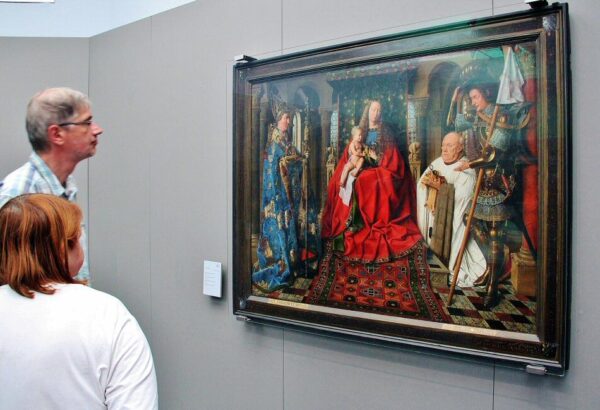
It is a visit that contains a special charm as it combines the possibility of reliving the atmosphere of an old medieval hospital with the possibility of enjoying the exhibition of the aforementioned paintings.
Specifically, these are the works of Hans memling, a 15th century artist from whom said institution commissioned various religious paintings that you can now see during your visit.
In fact, Hospital of San Juan It is also known today as Memling Museum. and after a major renovation, it will be open to the public again from December 2023.
Gothic Room of the Bruges Town Hall
During the visit of some monuments you will find corners that show great artistic wealth.
That is the case of the Gothic room of the Bruges Town Hall, which you find in the center Burg Square.

Your visit will focus on two large rooms, the aforementioned one being Gothic Room where you will have to sit and appreciate the beauty of its polychrome vault and 19th century wall paintings.
These paintings are an allegory of the relationship of the people of Bruges with their rulers.
Michelangelo sculpture in Bruges
When it comes to works of art, a surprise that you will get in your trip to bruges is to discover that in this Flemish city a sculpture of Miguel Angel, the great genius of Renacimiento Italian.
This is the sculpture of the Virgin and Child, which you find in the church of our lady, next to one of the most charming and most visited corners of the city, the Saint Boniface bridge.

This work was sculpted in marble Carrara by Miguel Angel in the year 1504, and although he carried it out at the request of the Siena Duomo, was finally acquired by a family from Bruges who moved it to said church.
Basilica of the Blood in Bruges
Another artistic corner that you cannot miss in Bruges is the Basilica of the Blood.
You also find it in the aforementioned Burg Square, next to the town hall building.
This small basilica with a pretty gothic facade has preserved since the 12th century some relics that are supposed to be from the Holy Blood of Christ, but it is on its second floor where you can see a sumptuous 15th century chapel.
ORGANIZE your TRIP
- Don't forget your TRAVEL INSURANCE with a 5% discount
- Book the HOTEL for your trip
- RENT a CAR for your trip
- The best TOURS and EXCURSIONS in Spanish
- NO-LINE TICKETS for museums and monuments
- Best FREE TOURS around the world
- Book your TRANSFER from the airport
- eSIM card with INTERNET at the best price
Decorated in Gothic style, you will see striking paintings on walls and ceiling, 17th century alabaster bas-relief y colorful stained glass, these already from the middle of the 14th century.
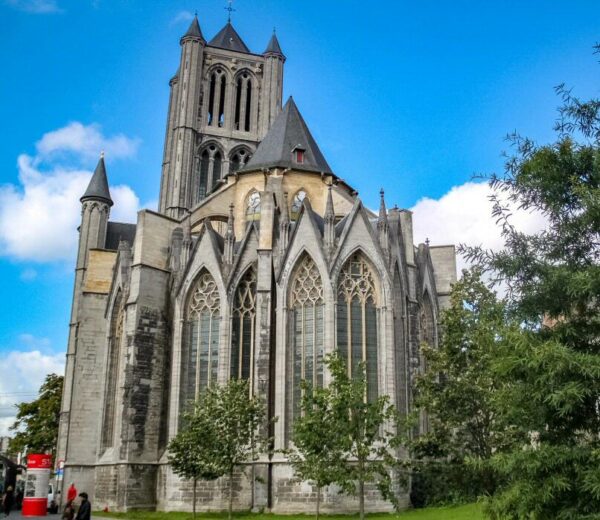
Another corner where you will spend a good time sitting on a bench appreciating its beauty.
Adoration of the Mystic Lamb in Ghent Cathedral
In in Ghent where you can see what, perhaps, is considered the most outstanding work and an icon of the paintings of the Flemish primitives, the Adoration of the Mystic Lamb.
In his St. Bavo's Cathedral you will be able to appreciate the artistic richness of this great altarpiece made by the Van Eyck brothers 1432 the year.
It should be noted that this work has survived numerous wars, being in the hands of Napoleon and being claimed by the Germans in the Second World War.
As a curiosity, one of its panels, the Just Judges, was stolen in 1934 and has not been recovered since, so a copy is shown.
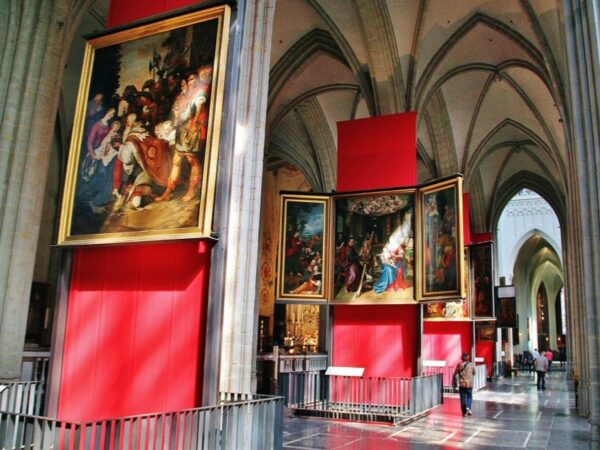
Currently, a restoration process is being completed on this work, which has become a essential to see on a trip to Ghent.
Rubens paintings in Antwerp
Antwerp, the second city in Belgium by size and population, is also the birthplace of Peter Paul Rubens, the great baroque painter who lived between the 16th and 17th centuries, and of whom you can see much of his work in the Prado Museum.
But do you know that in Antwerp, in churches and museums you can even 53 works by Rubens?
If you are interested in this flamenco school artist, a recommended visit is Rubens House-Museum located the home where he lived for 25 years.
It is currently undergoing renovation work, but when it reopens to visitors throughout 2024, you will find some of his works there, such as his famous self-portrait, as well as other contemporary artists such as Anthony van Dyck.

Another corner where you can also see paintings by Rubens It is in the imposing gothic cathedral of antwerp, on whose main altar you will see the canvas The Assumption of the Virgin.
It is one of the four works of this Antwerp artist which are part of the cathedral heritage and are exhibited therein.
Leuven Gothic Town Hall
From the artistic point of view, there are three corners that should focus your attention on the city tour of Leuven.
Without a doubt, its great artistic jewel is the façade of its flowery gothic style town hall, where the 236 sculptures that cover it stand out, which were placed at the beginning of the XNUMXth century on their respective niches, a time when this unfinished project had to be tackled.

Flemish primitives in the church of Saint Peter in Leuven
In front of the town hall building you can visit the church of San Pedro, the oldest in Leuven.
Much of its interior is reserved for a museum where exhibitions works of flamenco primitives, being the most prominent The Last Supper de Dirk bouts, made in 1468.
Tours and excursions in Flanders
Contemporary art in Leuven
And the third artistic corner to highlight in Leuven is, without a doubt, the M-Museum Leuven,
It is located in a building that is an architectural mix of a historical building and contemporary art, and inside you can see a collection that also combines old works with 19th century art.
Don't forget your Travel Insurance
Are you organizing your trip or getaway? Don't leave without take out your travel insurance before, and here we explain why. If you hire it with us, you have a 5% discount


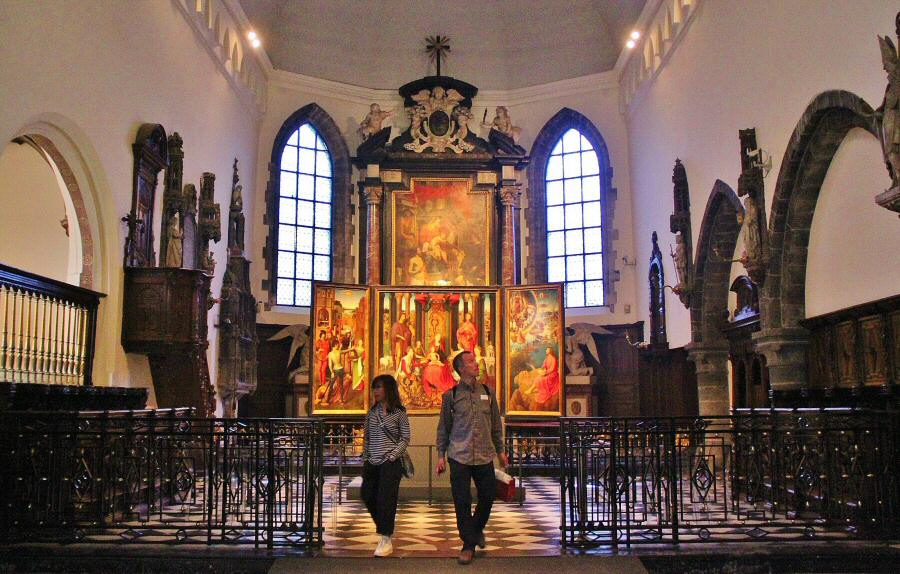
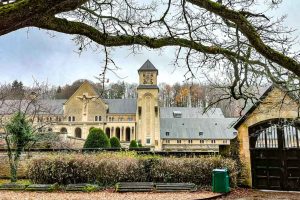
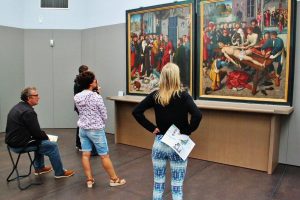
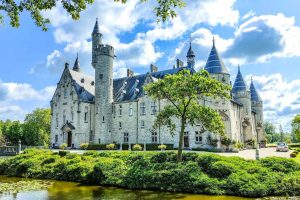











Comment